The 900 year old Sanjusangen-do Zen temple in Kyoto
Sanjusangen-do (Built in 1164 CE and reconstructed in 1266 after a fire broke out)
is a Buddhist temple in Kyoto that's guarded by around 1000- Armed Human sized
statues of Kannon, the Japanese Goddess of compassion. 500 statues sit on either
side of the main Deity of Sahasrabhuja-Arya-Avalokiteśvara.
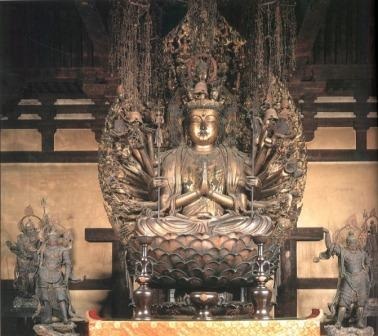 Sahasrabhuja-arya-avalokiteśvara
Sahasrabhuja-arya-avalokiteśvara
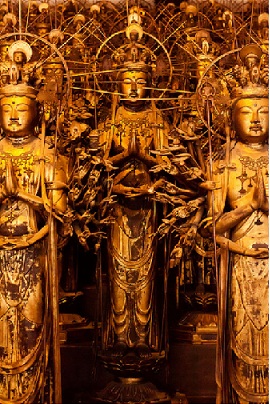 The 1000 armed Kannons
The 1000 armed Kannons
The 1000 life size Kannons carved from wood, have 28 guardian deities in front,
that are larger in size. These Guardian deities are of Indian origin and primarily
Hindu gods.
In ancient Japanese Buddhism, Hindu Deities are revered and given their place of
respect in the Buddhist realm of deities. The Hindu deities are considered guardian
Deities of the Buddhist concept of the ‘Clear Mind Buddha’. Which according
to them is the Buddha that is of prime importance. The physical Buddha is seen as
holy and revered, but he is also seen as an example of human bondage and suffering
in samsara. Like a normal human Buddha had to overcome his delusions and finally
had to shed the body. The ‘Clear Mind Buddha’ who is pristine and pure
in thought (Nirgun as the hindus say) however, is the primordial state without beginning
or end and is the state which all humans must aspire to achieve to get salvation
from rebirth. One has to not get obsessed with the physical Buddha, as he is external
to you, while the ‘Clear Mind Buddha’ is the object of possible achievement
for all humans through meditation and practice of dharma. This realization which
arises from within is considered more important than bondage to external objects,
however revered or holy they are.
This ‘Clear Mind Buddha’ as the silent observer, is similar to the
concept of the ‘Nirgun Bhraman or Paramatma’ in Hinduism, with all other
gods/goddesses being considered its emanations with specific energies, which is
very similar to the Shinto concepts of Kami. The beautiful Harmony with which the
ancient Japanese monks have managed to fit all gods and deities from the parent
stream of Hinduism into its brilliant offshoot Buddhism is remarkable. It is a brilliant
testimony to their abilities and vast intelligence to bring harmony, accommodation,
respect and deep understanding to the evolving spiritual streams, as well as merger
of existing streams. After all there is only one truth and no one has the monopoly
on it. This is something the ancient Japanese masters understood so well.
An achievement, one has to bow down to in deep respect.
Shintoism the original indigenous religion of Japan, Shinto teaches that everything
in nature consists of a spiritual essence, or a spirit called a Kami. The Kami resides
in all things. But there are certain designated places where the Kami interfaces
more intensely with people. There are 8 million kami (not literally, but just a
representation of many Kami that exist). The primary Kami is Amaterasu or the Goddess
of the sun. Hence Japan is called the land of the rising sun. This is extremely
similar to Hinduism where we are considered Suryavanshi (descendents of the sun).
In Hinduism, the entire universe is considered an emanation of Paramatma; hence
everything in it carries the spirit of the great creator. Lay people get confused
that Hinduism has a million deities, and villagers are busy creating one every day.
What an outsider does not see is that Hindus consider everything in nature as having
a spirit that is derived from that one source to manifest. So having a million deities
is the same as having one. Shintoism too is similar to that form and belief system
in Hinduism. Ancestors are considered Kami too and just as we worship and follow
the system of gotras (descendents of Rishis), they worship their ancestors.
In the next few frames , I shall post pictures of some of the critical Hindu “Guardian
Deities “ that have been exhibited in the Great 120 meter hall, which is 900
years old. These Guardian deities stand on either side of the Avalokiteshwara Deity
(The Buddhist God of compassion) and in front of the 1000 Kannons. The Hindu deities
don’t resemble the Indian versions as there were conceptually transplanted
about 900 years ago and are carved based on Japanese interpretations of Indian and
Chinese Sutras.
The descriptions are brief and have been copied from the official booklet available
at the Sanjusangen-do centre. It is highly recommended for any visitor to Japan
to visit this center and buy this book.
 Japanese Name: Naraen Kengo, Sanskrit: Narayana
Japanese Name: Naraen Kengo, Sanskrit: Narayana
The original Sanskrit name of this deity is Narayna, also called Vishnu in India,
the Hindu god of preservation of all creation. This god/statue is used in many ancient
Buddhist temples of Japan at the gates where Narayan keeps his mouth open in conjunction
with Vajra Pani (Shiva), who keeps his mouth closed. This according to them symbolizes
that the deities swallow all evil and let only virtue pass into the temple through
the gates. Another interpretation says they symbolize within lies all the secrets
of the universe from beginning to end. The most amazing example of these Deities
is at the entrance to the Todai-ji temple at Nara. Amazingly Nara has 7 prime temples
(Much like the Tirupathy temple, where the Lord is considered the lord of the seven
hills which represent the Adisesha or the serpent of Vishnu with 7 heads that is
supposed to hold up creation).
The placement of Narayna (Vishnu) and Vajra Pani (shiva) in the entrance to symbolize
AUM is amazing. A (mouth opens to symbolize beginning of all creation from Brahma,
who is born of Vishnu), and M (mouth shuts to symbolize the destroyer and therefore
the end of existence) is Shiva, the God of death. The Japanese Buddhist integration
with Hinduism is breath taking.
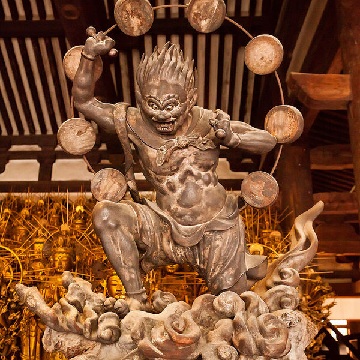 Japanese Name : Raijin the Thunder God, Sanskrit Name : Varuna
Japanese Name : Raijin the Thunder God, Sanskrit Name : Varuna
This deity has its origin in the god of water “Varuna” which later transformed
into Thunder God as water was always associated with thunder. The iconography of
this statue is based on ‘Senju Darani-kyo’ Buddhist Sutra. As per the
Rig Veda, Varuna is considered the counterpart of Mitra, Varuna rules the night
and Mitra rules during the day.
 Japanese Name: Basu senin Sanskrit: Vasu
Japanese Name: Basu senin Sanskrit: Vasu
Vasu in Hindu tradition can be interpreted in many ways. Vasudewa was the father
of Krishna. Related to this name is an early Hindu belief system, sometimes called
Bhagavatism that was largely formed by the 4th century BC.
Vasudeva was worshiped as the supreme Deity in a strongly monotheistic format, where
Vasudewa was considered the Supreme Being
because he had the attributes of being perfect, eternal and full of grace.
Vasu could also mean God of all the elements in creation which is very similar to
Japanese Shintoism wherein they recognize about 8 million gods of various elements
called Kami. Hinduism on the other hand recognizes 8 primary elements and all else
are its combinations. That is why Vasu is the god of the 8 gods or the various base
elements.
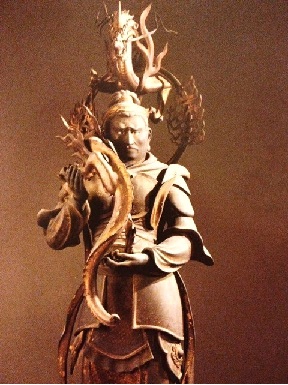 Japanese Name: Nanda Ryu-o Sanskrit: Nanda Naga Raja
Japanese Name: Nanda Ryu-o Sanskrit: Nanda Naga Raja
If the Sanskrit translation were to be applied directly, it would mean The King
of the snakes from the Nanda Dewi Mountain (The abode of Lord Shiva). In this carving
at some point of time the snakes became dragons through Chinese influence and came
to be in Japan, as Buddhism reached Japan via China and Tibet.
 Japanese Name: Fujin Sanskrit; Vayu
Japanese Name: Fujin Sanskrit; Vayu
As introduced in the ancient Indian sacred texts Rig Veda Vayu is the deity that
pulls carriages through the air, defeating armies, bring fame, fortune. The design
is completely based on Japanese interpretations of texts from Indian and Chinese
sutras.
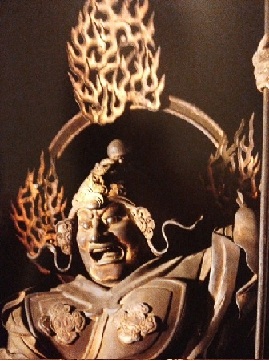 Japanese Name: Birubakusha Sanskrit: Virupaksha
Japanese Name: Birubakusha Sanskrit: Virupaksha
The Japanese translation means the deity with many eyes and a wider vision. Notice
the third eye between the two eyes, and the weapon in the hand is the same as Shivas.
In Hindu Tradition Virupaksha is a form of Shiva’s and there is indeed a Virupaksha
temple in Hampi Karnataka with the same Sanskrit name as in Japan.
 Japanese Name: Karura Sanskrit: Garuda
Japanese Name: Karura Sanskrit: Garuda
The original Sanskrit name of this deity is Garuda, In ancient India it was believed
to be a giant bird that ate cobras and carried the Hindu deity Vishnu on its back.
Later on it was adopted in Buddhism as a deity, and was included in the 8 guardians
of Buddhism. The statue represents a bird headed figure playing a flute while keeping
time with the foot.
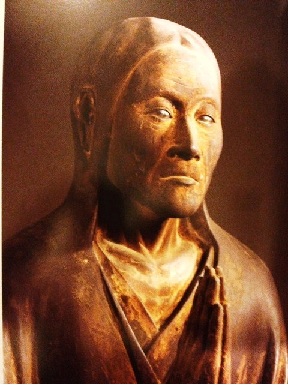 Japanese Name: Mawara-nyo. Sanskrit: Maha Bala
Japanese Name: Mawara-nyo. Sanskrit: Maha Bala.
Maha Bala in Hindu scriptures translates directly to Durga Dewi, based on whom,
many Bala mantras exist. Mawara-Nyo represents the indomitable spirit and the gentle
feminine subtle energies of the universe, gentle yet decisive.
 Japanese Name: Daibenkudoku-ten Sanskrit: Sridewi
Japanese Name: Daibenkudoku-ten Sanskrit: Sridewi
The original name for this deity is Sridewi, also called Laxmi, written in India
as Lakshmi. She is born from the sea and is Vishnus (Narayana’s) wife. In
Buddhism she is a daughter of the dragon King and Kishimojin (Hariti). As in Hinduism,
in Buddhism too, she presides over prosperity
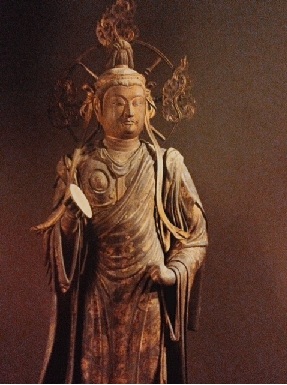 Japanese Name: Taishaku-ten Sanskrit: Indira
Japanese Name: Taishaku-ten Sanskrit: Indira
According to the ancient Indian writings in the Rig Veda, He is the most significant
heroic deity. In Buddhism this deity is supposed to live in Kiken castle As the
lord of the realm of Tory ten. He is considered to have helped Buddha in his novitiate
years. In Hinduism Indra is the god of the lesser heavens where ordinary mortals
reside for limited periods of time in their endless cycles of birth and death.
The very best for the last, This is where the Japanese place Hinduism and
Buddhism in perfect equal footing. Literally as parallel similar universes with
different tag names.
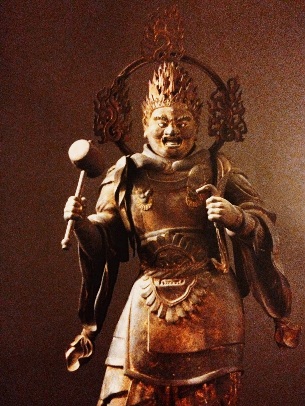 Japanese Name : Daibon-ten Sanskrit: Maha Brahman
Japanese Name : Daibon-ten Sanskrit: Maha Brahman
The Highest Hindu god and the creator of the universe is Maha Brahman.
Since Maha Brahman was adopted into Japanese Buddhism, it is
believed he is a guardian of Buddhism together with the Buddhist Deity
Taishaku-ten. They both are equally tasked as partners with running
the universe. According to the Japanese legend when Buddha reached self- realization,
he was overwhelmed but was hesitant to preach to people. Maha Brahman advised him
to start preaching in order to redeem ignorant people and their souls. It is for
this reason the Japanese accord Maha Brahman an equal status to the Buddhist diety
Taishaku-Ten.
About Author - In search of the ultimate truth beyond concepts and notions, in that
silence, after 20 years in soulless corporate board rooms. https://twitter.com/#!/sanjayrao1010
Also read
•
Pictures of Virupaksha Temple Hampi
•
Garuda is National symbol of Thailand. Pic no 3 has image.
•
Indian Cultural Influence on Japan
• The Great Buddha Statue in Bodh Gaya ie sponsored by the Japanese.
•
Bodh Gaya Temple pictures.
• Rajgir – Shanti Stupa ie sponsored by the Japanese.
• Japanese Monasteries at Bodh Gaya and many others.